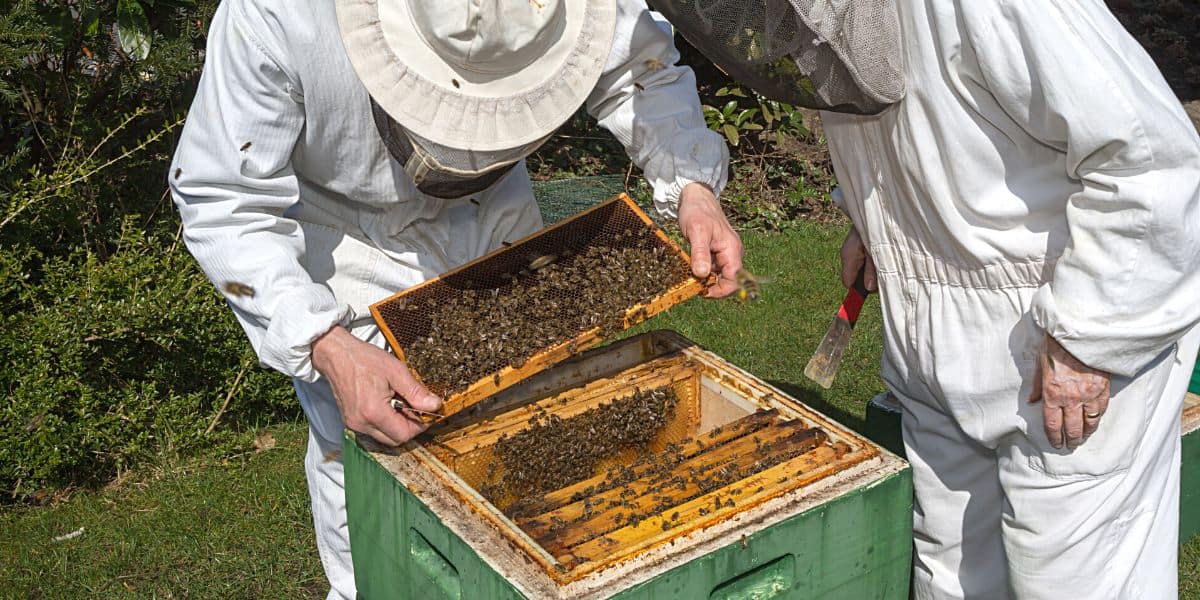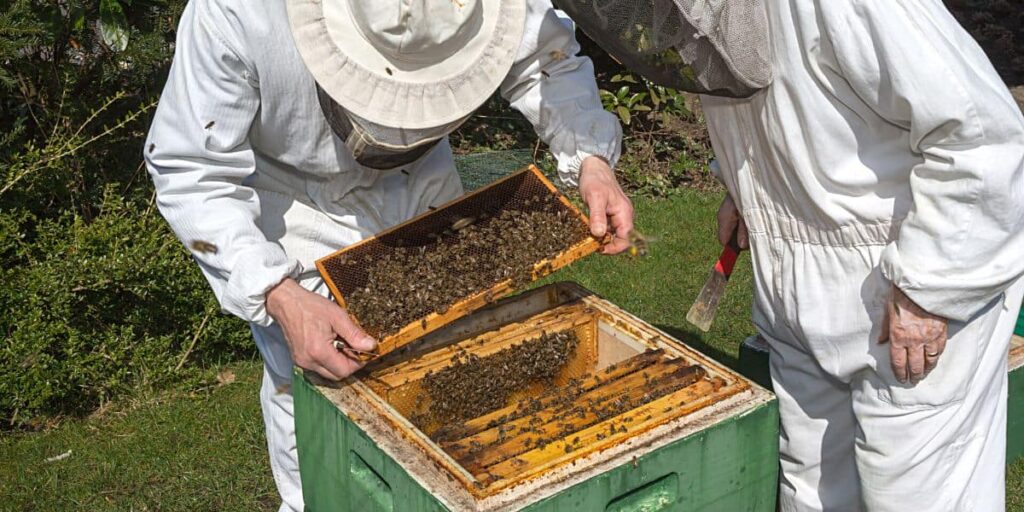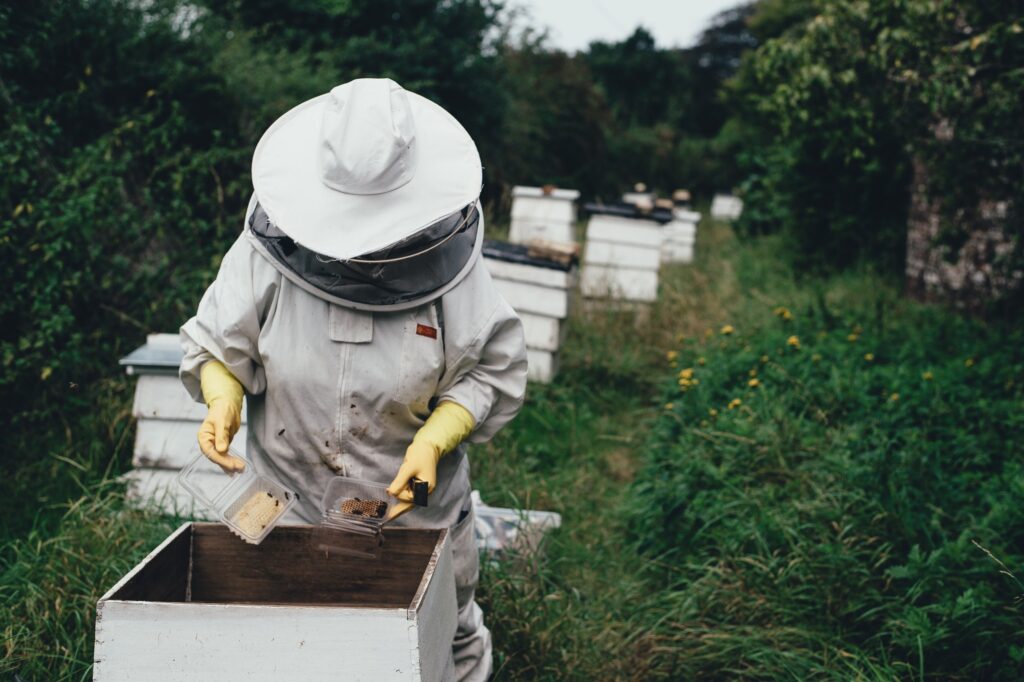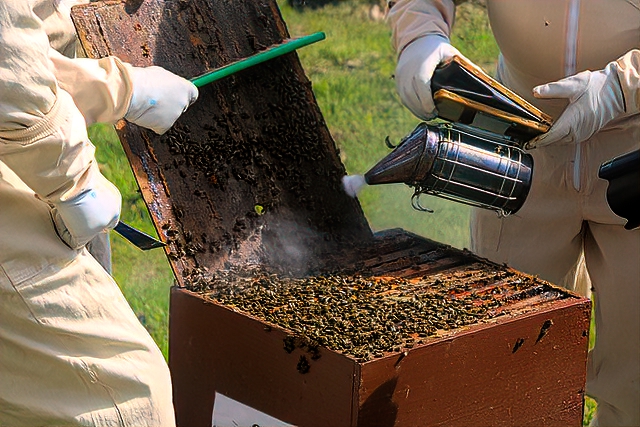
You’ve probably heard of beekeeping as a fascinating and environmentally important profession, but have you ever wondered about the financial aspect of it? In this article, we will explore the question on everyone’s mind: how much do beekeepers actually make per hour? We’ll uncover the factors that influence their earnings, from the size of their operations to the region they operate in. So, if you’ve ever been curious about the monetary rewards of this buzzing profession, keep reading to find out!
Factors Affecting Beekeepers’ Earnings
1.1 Location
Location plays a significant role in determining the earnings of beekeepers. The availability of nectar-rich flowers and a favorable climate directly impact the honey production, which ultimately affects the beekeepers’ profitability. Beekeepers situated in regions with abundant flora and longer blooming seasons are likely to have higher earnings compared to those located in areas with limited resources.
1.2 Experience and Skill Level
Experience and skill level are crucial factors that influence beekeepers’ earnings. Beekeepers who have spent years in the industry develop a deep understanding of bee behavior, hive management techniques, and effective strategies for maximizing honey production. With experience, they fine-tune their skills and become more efficient, leading to higher productivity and better financial returns.
1.3 Hive Size and Number of Hives
The size of beekeepers’ hives and the number of hives they maintain also impact their earnings. More hives mean more bees, which in turn results in a greater honey production potential. Additionally, larger hives can accommodate a higher population of bees, increasing the overall honey yield. However, managing larger hives requires more effort and expertise, which can influence the beekeeper’s ability to maximize their earnings effectively.
1.4 Honey Production
Honey production directly affects beekeepers’ earnings as it is their primary source of income. Factors such as the quality of nectar, presence of pesticides, and availability of water impact the quantity and quality of honey produced. Beekeepers who focus on maintaining healthy bee colonies and ensuring optimal honey production conditions are more likely to generate higher earnings than those who neglect these factors.
1.5 Type of Beekeeping
Different types of beekeeping have varying levels of profitability. While some beekeepers focus solely on honey production, others specialize in providing pollination services to farmers. Beekeepers who engage in pollination services often earn additional income by renting out their bees to farmers for crop pollination. The type of beekeeping pursued can significantly impact the beekeeper’s earnings potential.
1.6 Value-Added Products
Beekeepers can enhance their earnings by creating value-added products from honey and other hive by-products. These can include beeswax candles, pollen supplements, royal jelly, propolis, and other health products. Beekeepers who invest time and effort into developing and marketing such products can have a diversified income stream, contributing to overall higher earnings.
2. Average Earnings of Beekeepers
2.1 National Average
The average earnings of beekeepers vary depending on multiple factors, including region, experience level, honey production capacity, and market demand. According to industry reports, the national average earnings for beekeepers range from $30,000 to $60,000 per year. However, it is important to note that these figures represent a broad average and individual earnings can significantly differ based on aforementioned factors.
2.2 Regional Variances
Regional variances exist in beekeepers’ earnings due to variations in honey production, market demand, and the cost of living. Beekeepers operating in areas known for their diverse flora and strong demand for local honey may experience higher earnings than their counterparts in regions with limited resources or less demand. Additionally, the cost of living and regional economic conditions can impact the overall profitability of a beekeeping operation.
2.3 Comparison with Other Agriculture-Related Jobs
In comparison to other agriculture-related jobs, beekeeping can be financially rewarding. Some crop farmers may face unpredictable market conditions and yield fluctuations, which can directly impact their earnings. Beekeepers, on the other hand, have the advantage of multiple income streams – honey production, pollination services, and value-added products. This diversity can contribute to higher overall earnings and a more stable income compared to other farming practices.

3. Calculation Methods for Hourly Earnings
3.1 Hourly Rate for Beekeeping Services
Determining an hourly rate for beekeeping services requires considering various factors, including overhead costs, labor, and desired profit margin. Beekeepers can calculate their hourly rate by dividing their annual earnings goal by the number of hours worked in a year. This calculation method allows beekeepers to set their pricing structure, ensuring that they can cover their costs and achieve their desired earnings.
3.2 Calculating Earnings Based on Seasonal Demands
Beekeeping is a seasonal occupation, with peak demand occurring during the spring and summer months when bees are actively foraging and honey production is at its highest. Beekeepers can estimate their earnings by assessing previous years’ production data, taking into account the average honey yield per hive and the prevailing market prices. By analyzing seasonal demands, beekeepers can better determine the periods of higher earning potential and plan their activities and expenses accordingly.
3.3 Additional Income Streams
To maximize their earnings, beekeepers can explore additional income streams beyond traditional honey production. Renting out beehives for pollination services to farmers is a significant opportunity for generating additional revenue. Additionally, producing and selling value-added products like beeswax candles, honey-infused skincare products, or honey-based food products can diversify income sources and contribute to higher overall earnings.
4. Beekeepers’ Earnings Breakdown
4.1 Revenue from Honey Sales
Honey sales contribute significantly to beekeepers’ earnings. The amount earned from honey sales depends on factors such as the number of hives, honey production per hive, and prevailing market prices. High-quality honey, produced with attention to hive management and sustainable practices, can command premium prices, leading to increased revenue for beekeepers.
4.2 Pollination Services
Providing pollination services to farmers is an essential aspect of beekeeping that can generate substantial income. Many crops require pollination by bees to ensure optimal yields, and farmers are willing to pay beekeepers to bring their hives to their fields. Beekeepers who specialize in pollination services can earn additional income by renting out their hives during the bloom periods of specific crops, such as almonds, apples, or blueberries.
4.3 Wholesale and Retail Honey Products
Selling honey products directly to consumers through wholesale or retail channels is another avenue for beekeepers to increase their earnings. By establishing relationships with local stores, farmers markets, or online platforms, beekeepers can reach a broader customer base. The sale of honey products, including different varieties of honey, infused honey, and honey-based products, can generate higher profits compared to selling raw honey alone.
4.4 Value-Added Products and By-Products
Beekeepers can capitalize on the various by-products of their hive, such as beeswax, pollen supplements, propolis, and royal jelly, to create value-added products. These products often command higher prices and are sought after by health-conscious consumers. By investing in the production and marketing of value-added products, beekeepers can diversify their income and potentially increase their overall earnings.

5. Cost Considerations for Beekeepers
5.1 Startup and Operational Costs
Starting a beekeeping venture requires an initial investment in equipment, hives, bees, protective gear, and suitable apiary sites. These startup costs vary depending on the scale of the operation and the desired number of hives. Additionally, ongoing operational costs include regular hive maintenance, feeding bees, disease control measures, extraction equipment, transportation, and marketing expenses. Beekeepers must carefully consider these costs and plan their pricing and earnings targets accordingly.
5.2 Seasonal Expenses
Beekeepers also face seasonal expenses that fluctuate throughout the year. These can include costs associated with feeding bees during periods of nectar scarcity, queen replacement, swarm management, colony inspections, and disease prevention. Furthermore, expenses related to winter hive maintenance and protecting hives from cold temperatures and pests need to be factored into budgeting and earnings calculations.
5.3 Market Factors
The beekeeping industry is influenced by market factors that can impact beekeepers’ earnings. Fluctuations in honey prices, competition from imported honey, and shifts in consumer preferences or concerns can all introduce volatility into the market. Beekeepers must stay informed about market trends, consumer demands, and pricing dynamics to adapt their strategies and ensure sustainable earnings.
6. Government Support and Grants for Beekeepers
6.1 Subsidies and Grants
Governments and organizations worldwide recognize the importance of beekeeping for ecological sustainability and agriculture. As a result, many countries offer subsidies and grants to support beekeepers, especially those contributing to pollination services. These financial incentives can help beekeepers mitigate startup costs, invest in modern equipment, and develop sustainable practices, ultimately improving their earnings potential.
6.2 Tax Benefits and Incentives
In addition to direct subsidies and grants, beekeepers may also benefit from tax benefits and incentives provided by governments. These can include tax credits for hive maintenance expenses, exemptions for specific beekeeping equipment, or reduced tax rates for income generated through beekeeping activities. By taking advantage of these incentives, beekeepers can minimize their tax liabilities and further enhance their earnings.

7. Future Outlook for Beekeepers’ Earnings
7.1 Growing Demand for Honey and Related Products
The global demand for honey and honey-based products has been steadily increasing in recent years. Changing consumer preferences, the rising popularity of natural and healthy food alternatives, and increased awareness of the environmental benefits of beekeeping have contributed to this growing demand. Beekeepers can expect a positive outlook for their earnings as long as they adapt to market trends, maintain high-quality standards, and leverage marketing strategies to reach a wider consumer base.
7.2 Impact of Climate Change and Bee Health
Climate change and the health of bee populations pose challenges for beekeepers. Changing weather patterns, extreme temperatures, and habitat degradation can impact the availability of nectar-rich flowers, thereby affecting honey production. Additionally, the threat of pests, diseases, and colony collapse disorder can lead to bee losses and reduced productivity. Beekeepers must continually monitor and address these challenges to safeguard their earning potential.
7.3 Expanding Opportunities for Pollination Services
As the demand for food and crop production increases, the need for pollination services also grows. Beekeepers who specialize in providing pollination services can benefit from expanding opportunities with farmers and agricultural businesses. By establishing reliable partnerships and maintaining strong, healthy hives, beekeepers can expect continued growth in revenue through pollination services.
8. Challenges Faced by Beekeepers
8.1 Seasonal Nature of Work
Beekeeping is a seasonal occupation, with peak activity occurring during the warmer months. This seasonality poses challenges for beekeepers, as they must manage their income and expenses throughout the year. Proper financial planning and budgeting are crucial to ensure a stable income and cover the costs during the offseason.
8.2 Weather Conditions
Unfavorable weather conditions, such as excessive rainfall, droughts, or extreme temperatures, can negatively impact honey production and bee health. Beekeepers must be prepared to adapt their management practices and provide additional care to ensure their hives survive and thrive in challenging weather conditions. These adjustments may incur additional expenses, further emphasizing the importance of financial planning.
8.3 Pests and Diseases
The presence of pests, including varroa mites, small hive beetles, and wax moths, poses a significant threat to bee colonies. Infestations can weaken colonies, reduce honey production, and lead to colony losses if not appropriately addressed. Beekeepers must invest in effective pest management strategies, which may include the use of integrated pest control methods and disease prevention measures to protect their bees and preserve their profitability.
8.4 Varroa Mites
Varroa mites are a specific type of parasite that can ravage bee colonies if left uncontrolled. Their infestation weakens bees, compromises their immune system, and can lead to colony collapse. Beekeepers must actively monitor their hives for mite infestations and implement effective control measures to prevent the spread of this destructive parasite. Maintaining healthy and strong colonies is essential for maintaining steady earnings.
8.5 Market Competition
The beekeeping industry has seen an increased number of participants in recent years, leading to intensified competition. With more beekeepers entering the market, it is crucial to differentiate products and services to stand out. Building strong relationships with buyers, utilizing effective marketing strategies, and emphasizing the quality and sustainability of products can help beekeepers maintain a competitive edge and secure their earnings.

9. Important Skills and Knowledge for Successful Beekeeping
9.1 Understanding of Bee Behavior
Possessing a deep understanding of bee behavior is fundamental to successful beekeeping. Beekeepers must be able to read and interpret the behavior and communication within the hive to identify potential issues, anticipate swarm tendencies, and take appropriate preventive measures. This understanding enables beekeepers to maintain healthy and productive bee colonies, contributing to higher earnings.
9.2 Knowledge of Hive Management
Effective hive management is essential for optimizing honey production, ensuring bee health, and preventing pest and disease outbreaks. Successful beekeepers possess knowledge of hive inspection techniques, queen rearing, honey extraction methods, and general maintenance strategies. By actively managing their hives and implementing best practices, beekeepers can enhance their earnings and maintain sustainable operations.
9.3 Marketing and Sales Skills
To maximize their earnings, beekeepers must effectively market their products and services. Sound marketing strategies involve identifying target markets, building strong relationships with customers, and differentiating products from competitors. Additionally, having sales skills and the ability to communicate the value of their honey and related products can positively impact their market reach and ultimately drive higher profits.
11. Conclusion
Beekeeping can be a financially rewarding occupation, but success and earnings depend on various factors. Factors such as location, experience, hive size, honey production, and the type of beekeeping pursued all contribute to the overall earning potential of beekeepers. Understanding the market demand, diversifying income streams, and continuously investing in knowledge and skills are vital for ensuring stable earnings in the beekeeping industry. While challenges exist, beekeepers who stay informed, adapt to market trends, and prioritize the health of their bee colonies can expect a positive future outlook for their earnings.
